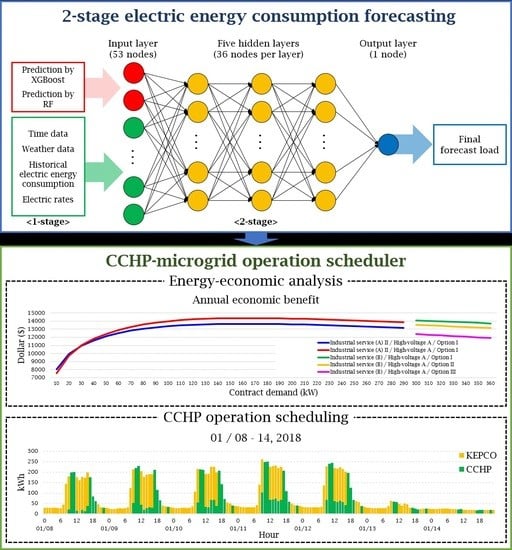A Two-Stage Industrial Load Forecasting Scheme for Day-Ahead Combined Cooling, Heating and Power Scheduling †
Abstract
1. Introduction
- (1)
- We propose a novel two-stage STLF scheme that can predict electric energy consumption accurately compared to other previous methods.
- (2)
- We propose a method to generate an optimal operation schedule of CCHP based on the predictive values of electric energy consumption and electric/gas charges in South Korea.
- (3)
- We propose a method to minimize the electric charge by calculating optimal contract demand and electric rate.
2. Related Works
2.1. Short-Term Load Forecasting
2.2. Our Previous Works
3. Input Variable Configuration
3.1. Time Data
3.2. Weather Data
3.3. Historical Electric Energy Consumption
3.4. Electric Rates
4. Two-Stage STLF Model Construction
4.1. The First Stage: Constructing Two STLF Models
4.1.1. Extreme Boosting Machine
4.1.2. Random Forest
4.2. The Second Stage: Combining STLF Models Using DNN
5. Economic Analysis Based CCHP Operation Scheduling
- The electric rate system divides the types of contracts according to the purpose of electricity usage, and applies the corresponding charges. The contract types are divided into six classes, namely, residential, general, industrial, educational, agricultural, and streetlights service. Some contract types have more granular rates, depending on the size of the voltage or the contract demand.
- The electric rate consists of the demand and energy charges. The demand charge recovers the fixed costs related to the electric energy supply equipment. It is determined based on the contract demand or peak load. On the other hand, the energy charge recovers the variable costs in proportion to usage.
- Seasonal and hourly differential electric rates are applied to some contract types, including industrial and general service. To reflect the differences in supply costs by time zone according to seasonal demand, high rates are charged in seasons and time zones with high electric energy consumption, and low rates are applied in seasons and time zones with low electric energy consumption.
- The electric rate system offers three options depending on the relative amount of the demand and energy charges: Option I, Option II, and Option III. For the demand charge, Option I > Option II > Option III and for the energy charges, Option I < Option II < Option III. These options are for reducing energy consumption, inducing voluntary peak time load management, and ultimately reducing the cost of power equipment by enabling consumers to select an electric rate depending on their load pattern.
| Algorithm 1. CCHP operation scheduling |
| Input: month m, day d, hour h Output: generation amount of CCHP , supply amount of public system if else if = = 0 else if = = else = 0 = return , |
6. Experimental Results
6.1. Comparison of Prediction Performance with Various STLF Models
6.2. Economic Analysis Based CCHP Operation Scheduling
7. Conclusions
Author Contributions
Funding
Conflicts of Interest
References
- Tabrizchi, H.; Javidi, M.M.; Amirzadeh, V. Estimates of residential building energy consumption using a multi-verse optimizer-based support vector machine with k-fold cross-validation. Evol. Syst. 2019, 1–13. [Google Scholar] [CrossRef]
- Morandin, M.; Bolognani, S.; Faggion, A. Active Torque Damping for an ICE-Based Domestic CHP System with an SPM Machine Drive. IEEE Trans. Ind. Appl. 2015, 51, 3137–3146. [Google Scholar] [CrossRef]
- Lee, S.K.; Mogi, G. Relative efficiency of energy technologies in the Korean mid-term strategic energy technology development plan. Renew. Sustain. Energy Rev. 2018, 91, 472–482. [Google Scholar] [CrossRef]
- Kenner, S.; Thaler, R.; Kucera, M.; Volbert, K.; Waas, T. Smart Grid Architecture for Monitoring and Analyzing, Including Modbus and REST Performance Comparison. In Proceedings of the 2015 12th International Workshop on Intelligent Solutions in Embedded Systems (WISES), Ancona, Italy, 29–30 October 2015; pp. 91–96. [Google Scholar]
- Saponara, S.; Saletti, R.; Mihet-Popa, L. Hybrid Micro-Grids Exploiting Renewables Sources, Battery Energy Storages, and Bi-Directional Converters. Appl. Sci. 2019, 9, 4973. [Google Scholar] [CrossRef]
- Ding, Z.; Lee, W.J.; Wang, J. Stochastic Resource Planning Strategy to Improve the Efficiency of Microgrid Operation. In Proceedings of the 2014 IEEE Industry Application Society Annual Meeting, Vancouver, BC, Canada, 5–9 October 2014; IEEE: Piscataway, NJ, USA, 2014. [Google Scholar]
- Banerji, A.; Biswas, S.K.; Singh, B. Enhancing Quality of Power to Sensitive Loads with Microgrid. IEEE Trans. Ind. Appl. 2015, 52, 360–368. [Google Scholar] [CrossRef]
- Pantaleo, A.M.; Camporeale, S.; Shah, N. Natural gas-biomass dual fuelled microturbines: Comparison of operating strategies in the Italian residential sector. Appl. Therm. Eng. 2014, 71, 686–696. [Google Scholar] [CrossRef]
- Mortaji, M.; Ow, S.H.; Moghavvemi, M.; Almurib, H.A.F. Load Shedding and Smart-Direct Load Control Using Internet of Things in Smart Grid Demand Response Management. IEEE Trans. Ind. Appl. 2017, 53, 5155–5163. [Google Scholar] [CrossRef]
- Zhu, R.; Guo, W.; Gong, X. Short-Term Load Forecasting for CCHP Systems Considering the Correlation between Heating, Gas and Electrical Loads Based on Deep Learning. Energies 2019, 12, 3308. [Google Scholar] [CrossRef]
- Sun, Z.; Li, L.; Bego, A.; Dababneh, F. Customer-side electricity load management for sustainable manufacturing systems utilizing combined heat and power generation system. Int. J. Prod. Econ. 2015, 165, 112–119. [Google Scholar] [CrossRef]
- Chen, Y.T. The Factors Affecting Electricity Consumption and the Consumption Characteristics in the Residential Sector—A Case Example of Taiwan. Sustainability 2017, 9, 1484. [Google Scholar] [CrossRef]
- Mocanu, E.; Nguyen, P.H.; Gibescu, M.; Kling, W.L. Deep Learning for Estimating Building Energy Consumption. Sustain. Energy Grids Netw. 2016, 6, 91–99. [Google Scholar] [CrossRef]
- Ahmad, A.S.; Hassan, M.Y.; Abdullah, M.P.; Rahman, H.A.; Hussin, F.; Abdullah, H.; Saidur, R. A review on applications of ANN and SVM for building electrical energy consumption forecasting. Renew. Sustain. Energy Rev. 2014, 33, 102–109. [Google Scholar] [CrossRef]
- Hong, T.; Fan, S. Probabilistic electric load forecasting: A tutorial review. Int. J. Forecast. 2016, 32, 914–938. [Google Scholar] [CrossRef]
- Dedinec, A.; Filiposka, S.; Dedinec, A.; Kocarev, L. Deep Belief Network based Electricity Load Forecasting: An Analysis of Macedonian Case. Energy 2016, 115, 1688–1700. [Google Scholar] [CrossRef]
- Guo, Y.; Nazarian, E.; Ko, J.; Rajurkar, K. Hourly cooling load forecasting using time-indexed ARX models with two-stage weighted least squares regression. Energy Convers. Manag. 2014, 80, 46–53. [Google Scholar] [CrossRef]
- Fan, S.; Chen, L. Short-term load forecasting based on an adaptive hybrid method. IEEE Trans. Power Syst. 2006, 21, 392–401. [Google Scholar] [CrossRef]
- Tian, C.; Hao, Y. A novel nonlinear combined forecasting system for short-term load forecasting. Energies 2018, 11, 712. [Google Scholar] [CrossRef]
- Kim, J.C.; Cho, S.M.; Shin, H.S. Advanced power distribution system configuration for smart grid. IEEE Trans. Smart Grid 2013, 4, 353–358. [Google Scholar] [CrossRef]
- Armstrong, J.S. Combining Forecasts: The End of the Beginning or the Beginning of the End? Int. J. Forecast. 1989, 5, 585–588. [Google Scholar] [CrossRef]
- Vaghefi, A.; Jafari, M.A.; Bisse, E.; Lu, Y.; Brouwer, J. Modeling and forecasting of cooling and electricity load demand. Appl. Energy 2014, 136, 186–196. [Google Scholar] [CrossRef]
- Bagnasco, A.; Fresi, F.; Saviozzi, M.; Silvestro, F.; Vinci, A. Electrical consumption forecasting in hospital facilities: An application case. Energy Build. 2015, 103, 261–270. [Google Scholar] [CrossRef]
- Powell, K.M.; Sriprasad, A.; Cole, W.J.; Edgar, T.F. Heating, cooling, and electrical load forecasting for a large-scale district energy system. Energy 2014, 74, 877–885. [Google Scholar] [CrossRef]
- Jurado, S.; Nebot, À.; Mugica, F.; Avellana, N. Hybrid methodologies for electricity load forecasting: Entropy-based feature selection with machine learning and soft computing techniques. Energy 2015, 86, 276–291. [Google Scholar] [CrossRef]
- Sandels, C.; Widén, J.; Nordström, L.; Andersson, E. Day-ahead predictions of electricity consumption in a Swedish office building from weather, occupancy, and temporal data. Energy Build. 2015, 108, 279–290. [Google Scholar] [CrossRef]
- Grolinger, K.; L’Heureux, A.; Capretz, M.A.; Seewald, L. Energy forecasting for event venues: Big data and prediction accuracy. Energy Build. 2016, 112, 222–233. [Google Scholar] [CrossRef]
- Gerossier, A.; Girard, R.; Kariniotakis, G.; Michiorri, A. Probabilistic Day-Ahead Forecasting of Household Electricity Demand. CIRED-Open Access Proc. J. 2017, 2017, 2500–2504. [Google Scholar] [CrossRef]
- Chen, Y.; Tan, H. Short-term prediction of electric demand in building sector via hybrid support vector regression. Appl. Energy 2017, 204, 1363–1374. [Google Scholar] [CrossRef]
- Dong, Y.; Zhang, Z.; Hong, W.C. A hybrid seasonal mechanism with a chaotic cuckoo search algorithm with a support vector regression model for electric load forecasting. Energies 2018, 11, 1009. [Google Scholar] [CrossRef]
- Fan, G.F.; Peng, L.L.; Hong, W.C. Short term load forecasting based on phase space reconstruction algorithm and bi-square kernel regression model. Appl. Energy 2018, 224, 13–33. [Google Scholar] [CrossRef]
- Hong, W.C.; Fan, G.F. Hybrid Empirical Mode Decomposition with Support Vector Regression Model for Short Term Load Forecasting. Energies 2019, 12, 1093. [Google Scholar] [CrossRef]
- Moon, J.; Park, J.; Hwang, E.; Jun, S. Forecasting power consumption for higher educational institutions based on machine learning. J. Supercomput. 2018, 74, 3778–3800. [Google Scholar] [CrossRef]
- Son, M.; Moon, J.; Jung, S.; Hwang, E. A Short-Term Load Forecasting Scheme Based on Auto-Encoder and Random Forest. In Proceedings of the 3rd International Conference on Applied Physics, System Science and Computers (APSAC), Dubrovnik, Croatia, 26–28 September 2018; pp. 138–144. [Google Scholar]
- Kim, J.; Moon, J.; Hwang, E.; Kang, P. Recurrent inception convolution neural network for multi short-term load forecasting. Energy Build. 2019, 194, 328–341. [Google Scholar] [CrossRef]
- Moon, J.; Park, S.; Rho, S.; Hwang, E. A comparative analysis of artificial neural network architectures for building energy consumption forecasting. Int. J. Distrib. Sens. Netw. 2019, 15, 1550147719877616. [Google Scholar] [CrossRef]
- Park, S.; Moon, J.; Hwang, E. 2-Stage Electric Load Forecasting Scheme for Day-Ahead CCHP Scheduling. In Proceedings of the 13th IEEE International Conference on Power Electronics and Drive Systems (PEDS), Toulouse, France, 9–12 July 2019. [Google Scholar]
- Moon, J.; Kim, Y.; Son, M.; Hwang, E. Hybrid Short-Term Load Forecasting Scheme Using Random Forest and Multilayer Perceptron. Energies 2018, 11, 3283. [Google Scholar] [CrossRef]
- Wang, P.; Liu, B.; Hong, T. Electric load forecasting with recency effect: A big data approach. Int. J. Forecast. 2016, 32, 585–597. [Google Scholar] [CrossRef]
- Xie, J.; Chen, Y.; Hong, T.; Laing, T.D. Relative humidity for load forecasting models. IEEE Trans. Smart Grid 2016, 9, 191–198. [Google Scholar] [CrossRef]
- Xie, J.; Hong, T. Wind speed for load forecasting models. Sustainability 2017, 9, 795. [Google Scholar] [CrossRef]
- Iglesias, F.; Kastner, W. Analysis of similarity measures in times series clustering for the discovery of building energy patterns. Energies 2013, 6, 579–597. [Google Scholar] [CrossRef]
- Lee, W.; Jung, J.; Lee, M. Development of 24-hour optimal scheduling algorithm for energy storage system using load forecasting and renewable energy forecasting. In Proceedings of the 2017 IEEE Power & Energy Society General Meeting (PESGM), Chicago, IL, USA, 16–20 July 2017. [Google Scholar]
- Raza, M.Q.; Khosravi, A. A review on artificial intelligence based load demand forecasting techniques for smart grid and buildings. Renew. Sustain. Energy Rev. 2015, 50, 1352–1372. [Google Scholar] [CrossRef]
- Lee, W.; Jung, J.; Kang, B.O. Cost-Benefit Analysis for Industrial Customers-Installed Energy Storage System in South Korea. In Proceedings of the 2018 IEEE Innovative Smart Grid Technologies-Asia (ISGT Asia), Singapore, 22–25 May 2018. [Google Scholar]
- Le, T.; Vo, M.T.; Vo, B.; Hwang, E.; Rho, S.; Baik, S.W. Improving electric energy consumption prediction using CNN and Bi-LSTM. Appl. Sci. 2019, 9, 4237. [Google Scholar] [CrossRef]
- Lindner, C.; Bromiley, P.A.; Ionita, M.C.; Cootes, T.F. Robust and accurate shape model matching using random forest regression-voting. IEEE Trans. Pattern Anal. Mach. Intell. 2014, 37, 1862–1874. [Google Scholar] [CrossRef] [PubMed]
- Gómez-Ríos, A.; Luengo, J.; Herrera, F. A study on the noise label influence in boosting algorithms: AdaBoost, GBM and XGBoost. In Proceedings of the 12th International Conference, HAIS 2017, La Rioja, Spain, 21–23 June 2017; Springer: Cham, Switzerland, 2017; pp. 268–280. [Google Scholar]
- Qingqing, K.; Xiangqian, D.; Huili, G. Application of improved random forest pruning algorithm in tobacco origin identification of near infrared spectrum. Laser Optoelectron. Prog. 2018, 55, 446–451. [Google Scholar]
- Chen, T.; Guestrin, C. Xgboost: A scalable tree boosting system. In Proceedings of the 22nd ACM SIGKDD International Conference on Knowledge Discovery and Data Mining, San Francisco, CA, USA, 13–17 August 2016. [Google Scholar]
- Ruiz-Abellón, M.; Gabaldón, A.; Guillamón, A. Load forecasting for a campus university using ensemble methods based on regression trees. Energies 2018, 11, 2038. [Google Scholar] [CrossRef]
- Schapire, R.E. The boosting approach to machine learning: An overview. In Nonlinear Estimation and Classification; Springer: Berlin, Germany, 2003; pp. 149–171. [Google Scholar]
- Breiman, L. Bagging predictors. Mach. Learn. 1996, 24, 123–140. [Google Scholar] [CrossRef]
- Liang, Y.; Niu, D.; Hong, W.C. Short term load forecasting based on feature extraction and improved general regression neural network model. Energy 2019, 166, 653–663. [Google Scholar] [CrossRef]
- Baek, S.J.; Yoon, S.G. Short-Term Load Forecasting for Campus Building with Small-Scale Loads by Types Using Artificial Neural Network. In Proceedings of the 2019 IEEE Power & Energy Society Innovative Smart Grid Technologies Conference (ISGT), Washington, DC, USA, 18–21 February 2019. [Google Scholar]
- Liu, P.; Zheng, P.; Chen, Z. Deep Learning with Stacked Denoising Auto-Encoder for Short-Term Electric Load Forecasting. Energies 2019, 12, 2445. [Google Scholar] [CrossRef]
- Ryu, S.; Noh, J.; Kim, H. Deep neural network based demand side short term load forecasting. Energies 2017, 10, 3. [Google Scholar] [CrossRef]
- Shi, H.; Xu, M.; Li, R. Deep learning for household load forecasting—A novel pooling deep RNN. IEEE Trans. Smart Grid 2017, 9, 5271–5280. [Google Scholar] [CrossRef]
- Heaton, J. Introduction to Neural Networks with Java; Heaton Research, Inc.: Chesterfield, MO, USA, 2008; ISBN 1-60439-008-5. [Google Scholar]
- Li, H.; Fu, L.; Geng, K.; Jiang, Y. Energy utilization evaluation of CCHP systems. Energy Build. 2006, 38, 253–257. [Google Scholar] [CrossRef]
- Allen, D.T.; Torres, V.M.; Thomas, J.; Sullivan, D.W.; Harrison, M.; Hendler, A.; Herndon, S.C.; Kolb, C.E.; Fraser, M.P.; Hill, A.D.; et al. Measurements of methane emissions at natural gas production sites in the United States. Proc. Natl. Acad. Sci. USA 2013, 110, 17768–17773. [Google Scholar] [CrossRef]
- Van Ruijven, B.; Van Vuuren, D.P. Oil and natural gas prices and greenhouse gas emission mitigation. Energy Policy 2009, 37, 4797–4808. [Google Scholar] [CrossRef]
- Yun, R. Economic analysis of CHP system for building by CHP capacity optimizer. Korean J. Air-Cond. Refrig. Eng. 2008, 20, 321–326. [Google Scholar]
- Kuo, P.H.; Huang, C.J. A high precision artificial neural networks model for short-term energy load forecasting. Energies 2018, 11, 213. [Google Scholar] [CrossRef]

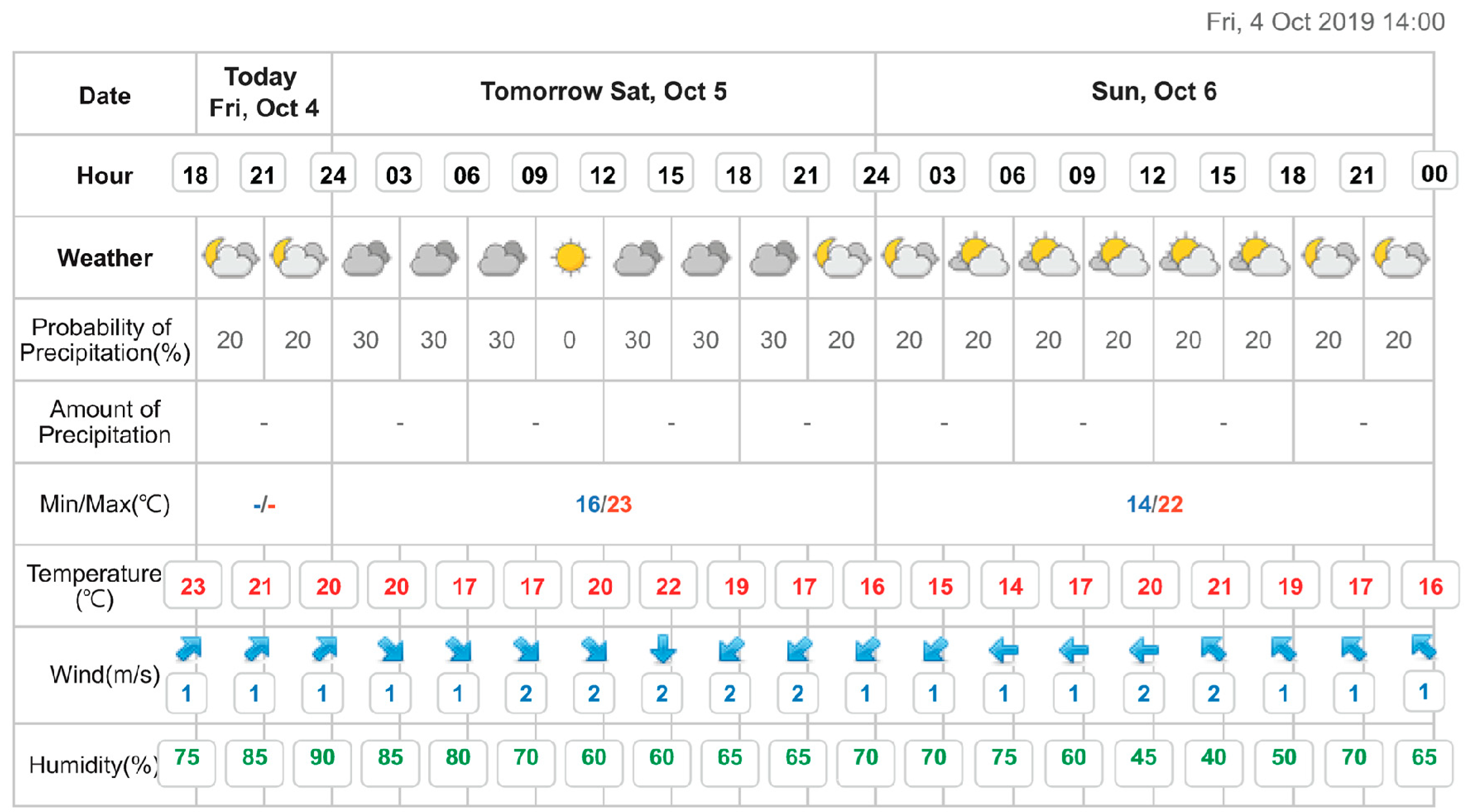
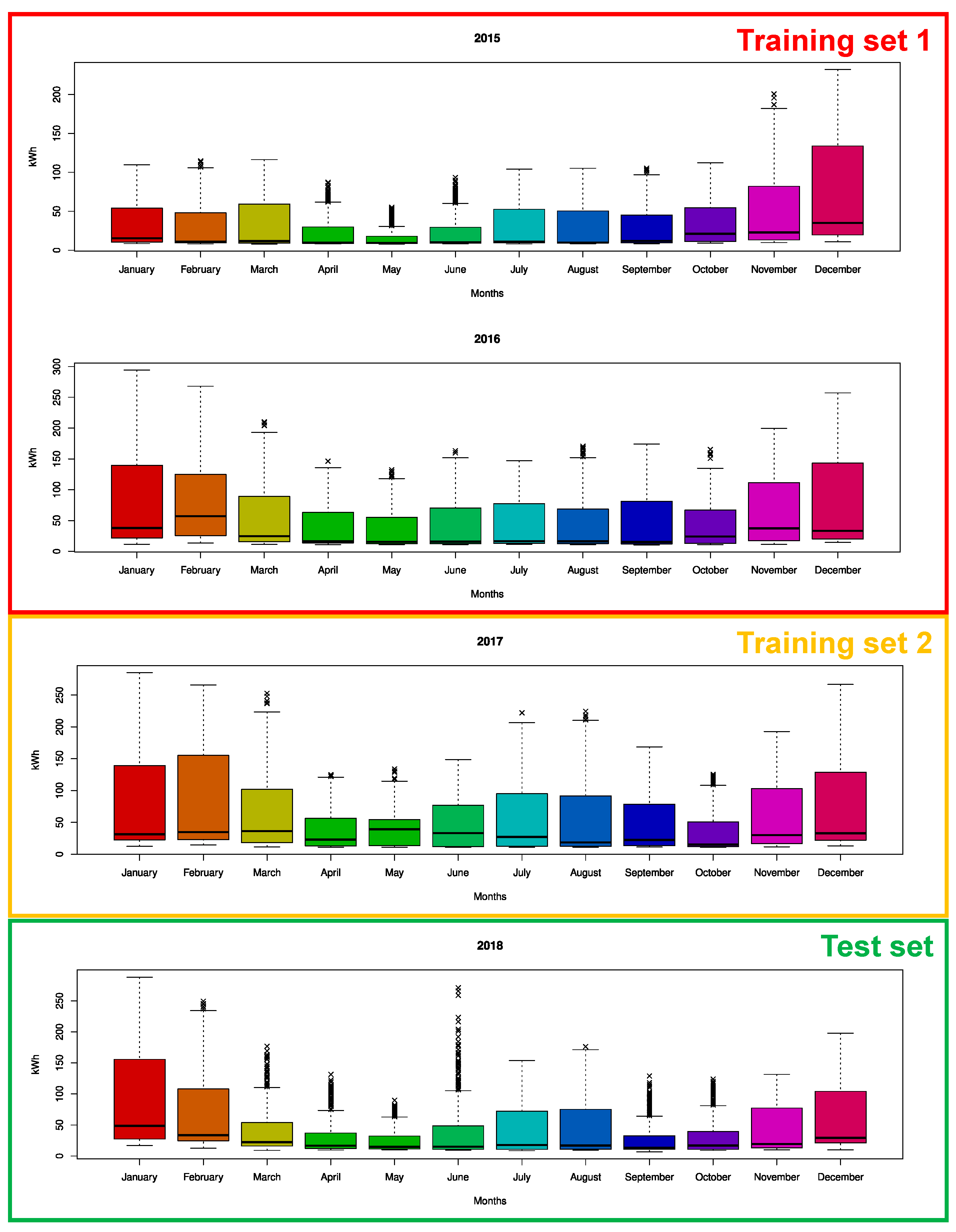
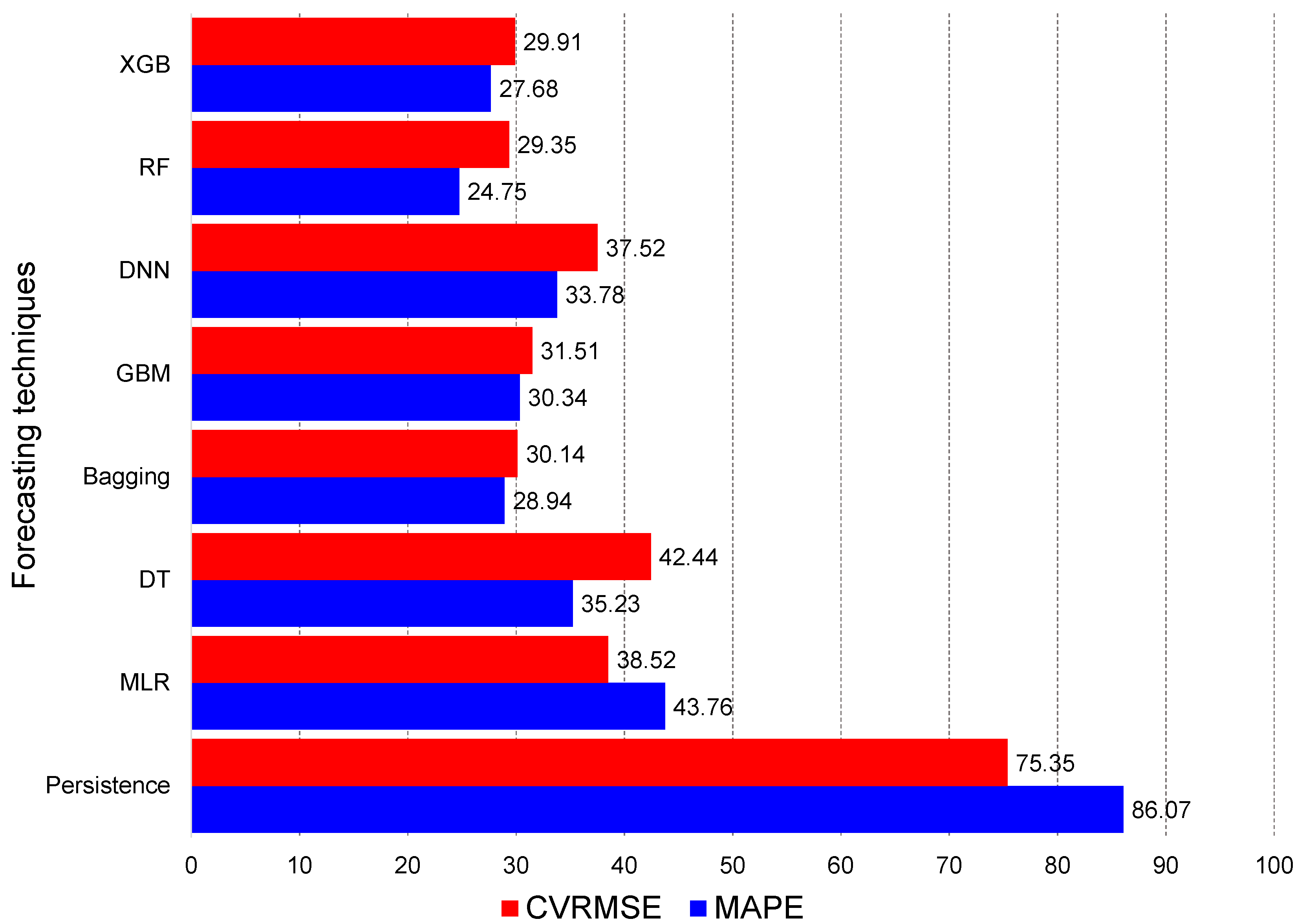
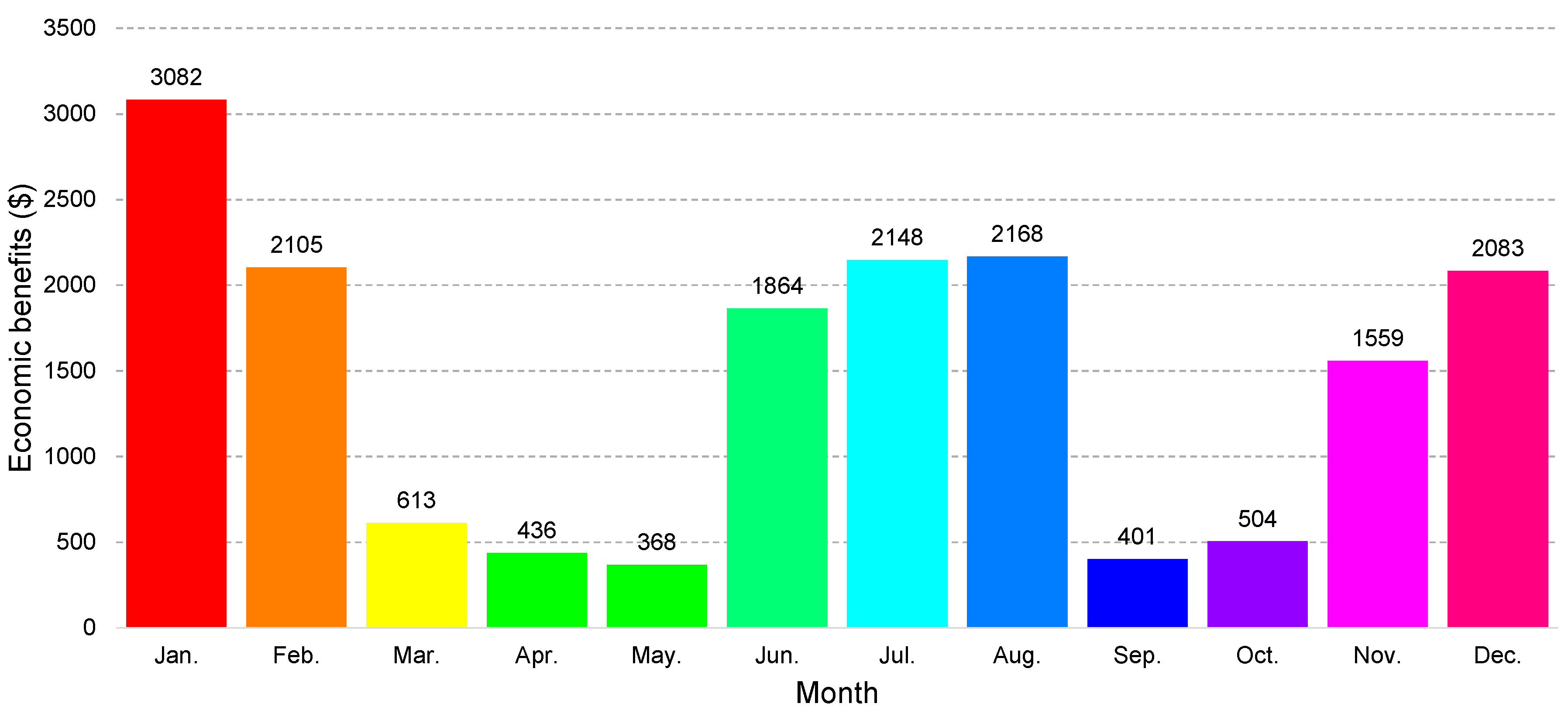
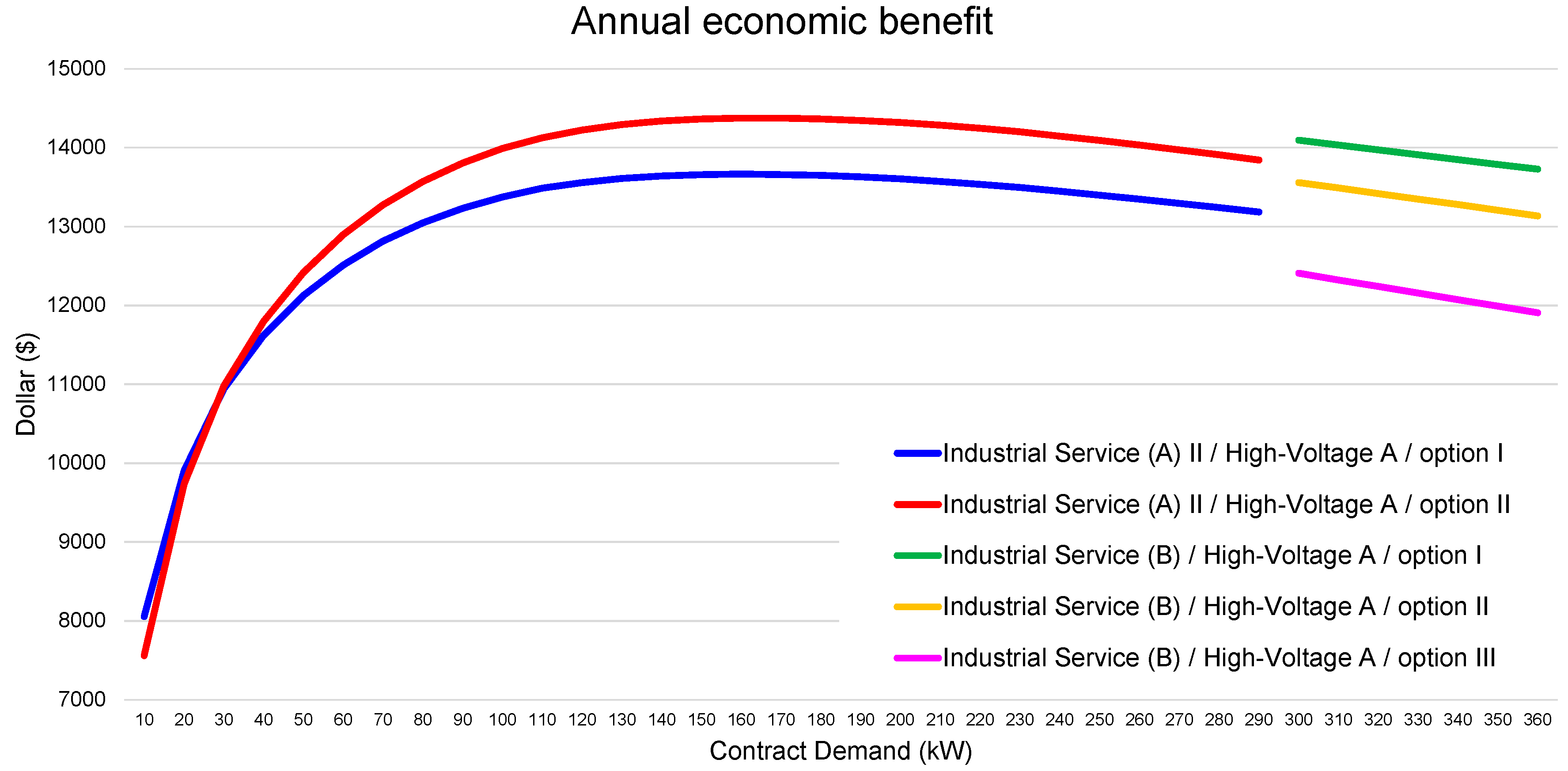
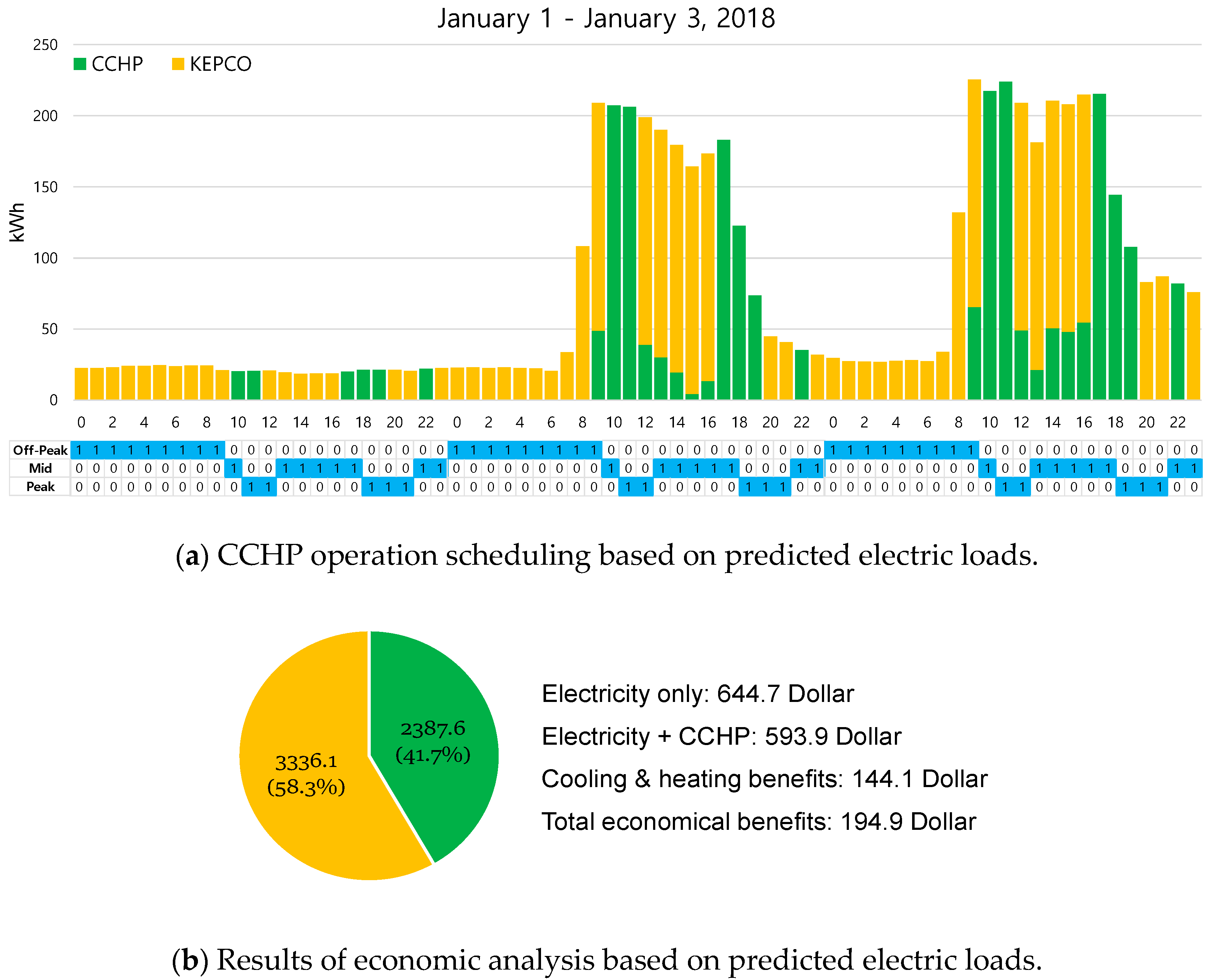
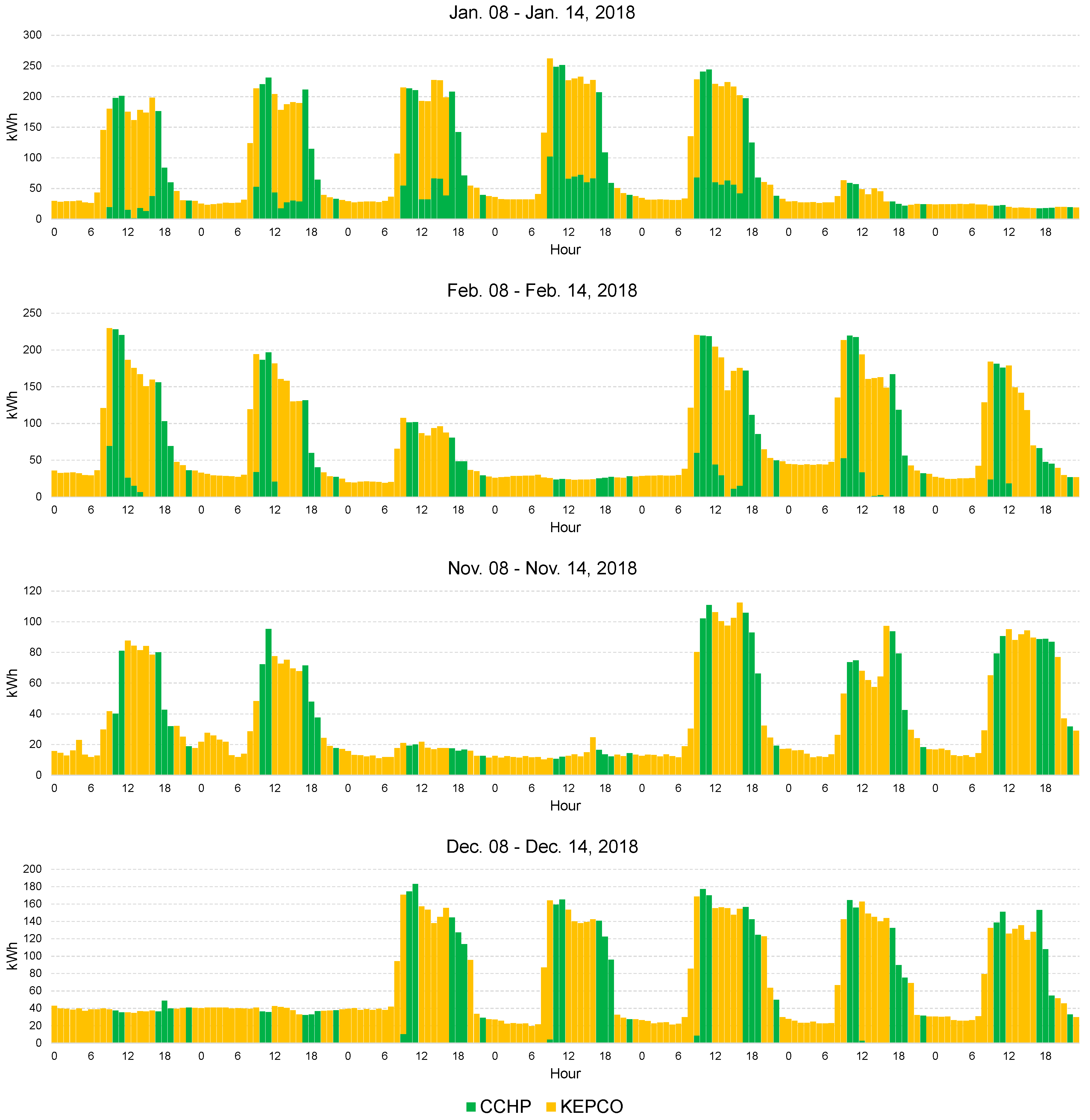

| Author (Year) | Target | Types of Input Variables | Forecasting Method | Description |
|---|---|---|---|---|
| Vaghefi et al. [22] (2014) | A CCHP plant at University of California | Historical load, weather, time | Cochrane–Orcutt estimation | This approach utilized the advantage of both time series and regression methods. |
| Bagnasco et al. [23] (2014) | Cellini Medical Clinic | Historical load, weather, time | ANN | The model can be easily integrated into a building energy management system or into a real-time monitoring system. |
| Powell et al. [24] (2014) | College campus building | Weather, time | Nonlinear autoregressive model | 95% confidence limits are used to quantify the uncertainty of the predictions. |
| Jurado et al. [25] (2015) | Three buildings of the UPC | Historical load, time | RF, ANN, FIR, ARIMA | The approaches discussed generate fast and reliable models, with low computational costs. |
| Sandels et al. [26] (2015) | Office building | Weather, electricity price, occupancy | Regression model | Occupancy is correlated with appliance load, and outdoor temperature and a temporal variable defining work hours are connected with ventilation and cooling load. |
| Grolinger et al. [27] (2016) | A large event-organizing venue | Historical load, time, event | ANN, SVR | Daily data intervals resulted in higher consumption prediction accuracy than hourly or 15 min readings. |
| Gerossier et al. [28] (2017) | A neighborhood comprising 226 individual buildings | Historical load, weather | Quantile smoothing splines regression | Providing probabilistic forecasts by computing a list of quantiles. |
| Chen et al. [29] (2017) | Mall and hotel | Historical load, weather | SVR | Multi-resolution wavelet decomposition can always improve the predicting accuracy for the hotel, while it is not necessary for the mall. |
| Dong et al. [30] (2018) | National electricity market, New York Independent system operator | Historical load | SSVRCCS | SSVRCCS model is employed to improve the forecasting accuracy level by sufficiently capturing the non-linear and cyclic tendency of electric load changes. |
| Fan et al. [31] (2018) | New South Wales market, New York Independent system operator | Historical load | PSR-BSK | Their proposed model can extract some valuable features embedded in the time series to demonstrate the relationships of the nonlinearity. |
| Hong et al. [32] (2019) | New South Wales market | Historical load | H-EMD-SVR-PSO | Decomposed intrinsic mode functions could be defined as three items and there three items would be modeled separately by the SVR-PSO model. |
| Statistics | Energy Consumption (kWh) |
|---|---|
| Mean | 46.26 |
| Standard error | 0.26 |
| Median | 22.94 |
| Mode | 11.88 |
| Standard deviation | 49.59 |
| Sample variance | 2459.36 |
| Kurtosis | 2.94 |
| Skewness | 1.80 |
| Range | 287.52 |
| Minimum | 6.63 |
| Maximum | 294.15 |
| Sum | 1,622,214.17 |
| Count | 35,064 |
| No. | Input Variables | Type of Variables |
|---|---|---|
| 1 | Month | Continuous on [1, 12] |
| 2 | Day | Continuous on [1, 31] |
| 3 | Hour | Continuous on [0, 23] |
| 4 | Continuous on [−1, 1] | |
| 5 | Continuous on [−1, 1] | |
| 6 | Continuous on [−1, 1] | |
| 7 | Continuous on [−1, 1] | |
| 8 | Continuous on [−1, 1] | |
| 9 | Continuous on [−1, 1] | |
| 10 | Continuous on [−1, 1] | |
| 11 | Continuous on [−1, 1] | |
| 12 | Monday | Binary |
| 13 | Tuesday | Binary |
| 14 | Wednesday | Binary |
| 15 | Thursday | Binary |
| 16 | Friday | Binary |
| 17 | Saturday | Binary |
| 18 | Sunday | Binary |
| 19 | Holiday | Binary |
| Regression Statistics | 1-Dimensional | 2-Dimensional | 1-Dimensional + 2-Dimensional |
|---|---|---|---|
| Multiple R | 0.190 | 0.609 | 0.614 |
| R-squared | 0.036 | 0.371 | 0.377 |
| Adjusted R-squared | 0.036 | 0.370 | 0.377 |
| Standard error | 48.978 | 39.579 | 39.365 |
| Hour | Avg. Temp. | Min. Temp. | Max. Temp. | Prec. | Temp. | Wind speed | Humi. | DI | WC |
|---|---|---|---|---|---|---|---|---|---|
| 1 | 1.1 | −2.3 | 4.7 | 0 | −1.8 | 1.6 | 40.4 | 38.34 | −1.03 |
| 2 | 1.1 | −2.3 | 4.7 | 0 | −2.0 | 1.3 | 42.5 | 37.76 | −0.81 |
| 3 | 1.1 | −2.3 | 4.7 | 0 | −1.6 | 2.9 | 43.1 | 38.16 | −2.11 |
| 4 | 1.1 | −2.3 | 4.7 | 0 | −1.9 | 3.9 | 43.0 | 37.80 | −3.13 |
| 5 | 1.1 | −2.3 | 4.7 | 0 | −2.0 | 2.8 | 41.4 | 37.94 | −2.46 |
| 6 | 1.1 | −2.3 | 4.7 | 0 | −2.3 | 3.3 | 41.4 | 37.57 | −3.18 |
| 7 | 1.1 | −2.3 | 4.7 | 0 | −2.3 | 2.9 | 41.4 | 37.57 | −2.87 |
| 8 | 1.1 | −2.3 | 4.7 | 0 | −2.2 | 2.4 | 41.2 | 37.73 | −2.33 |
| 9 | 1.1 | −2.3 | 4.7 | 0 | −2.1 | 2.4 | 43.2 | 37.52 | −2.22 |
| 10 | 1.1 | −2.3 | 4.7 | 0 | −1.1 | 3.3 | 40.1 | 39.24 | −1.85 |
| 11 | 1.1 | −2.3 | 4.7 | 0 | −0.1 | 4.1 | 42.0 | 40.17 | −1.24 |
| 12 | 1.1 | −2.3 | 4.7 | 0 | 1.1 | 3.9 | 44.3 | 41.34 | 0.21 |
| 13 | 1.1 | −2.3 | 4.7 | 0 | 2.7 | 2.8 | 46.4 | 43.09 | 2.65 |
| 14 | 1.1 | −2.3 | 4.7 | 0 | 4.7 | 2.5 | 46.7 | 45.60 | 5.03 |
| 15 | 1.1 | −2.3 | 4.7 | 0 | 3.2 | 4.0 | 57.1 | 42.54 | 2.50 |
| 16 | 1.1 | −2.3 | 4.7 | 0 | 2.7 | 3.6 | 76.1 | 39.64 | 2.16 |
| 17 | 1.1 | −2.3 | 4.7 | 0 | 2.4 | 2.8 | 85.4 | 38.06 | 2.33 |
| 18 | 1.1 | −2.3 | 4.7 | 0 | 2.6 | 3.7 | 86.0 | 38.32 | 1.99 |
| 19 | 1.1 | −2.3 | 4.7 | 0 | 2.5 | 2.8 | 83.1 | 38.50 | 2.44 |
| 20 | 1.1 | −2.3 | 4.7 | 0 | 2.8 | 3.1 | 81.3 | 39.20 | 2.56 |
| 21 | 1.1 | −2.3 | 4.7 | 0 | 2.8 | 2.8 | 82.8 | 39.02 | 2.76 |
| 22 | 1.1 | −2.3 | 4.7 | 0 | 2.8 | 3.4 | 83.6 | 38.93 | 2.38 |
| 23 | 1.1 | −2.3 | 4.7 | 0 | 2.9 | 1.4 | 82.9 | 39.17 | 4.14 |
| 24 | 1.1 | −2.3 | 4.7 | 0 | 3.1 | 2.1 | 81.1 | 39.70 | 3.63 |
| Classification | Charge (Won/MJ) |
|---|---|
| Winter (Dec., Jan., Feb., Mar.) | 14.627 |
| Summer (Jun., Jul., Aug., Sep.) | 13.988 |
| Spring/Fall (Apr., May, Oct., Nov.) | 14.061 |
| Classification | Demand Charge (Won/kW) | Energy charge (Won/kWh) | ||||
|---|---|---|---|---|---|---|
| Time Period | Summer (1 June~31 August) | Spring/Fall (1 March~31 May/ 1 September~31 October) | Winter (1 November~28 February) | |||
| High-Voltage A | Option I | 7220 | Off-peak load | 61.6 | 61.6 | 68.6 |
| Mid-load | 114.5 | 84.1 | 114.7 | |||
| Peak-load | 196.6 | 114.8 | 172.2 | |||
| Machine Learning Algorithms | Correlation Coefficient |
|---|---|
| Extreme gradient boosting | 0.941 |
| Random forest | 0.942 |
| Deep neural networks | 0.916 |
| Gradient boosting machine | 0.916 |
| Bagging | 0.924 |
| Decision tree | 0.890 |
| Multiple linear regression | 0.913 |
| Persistence | 0.612 |
| Forecasting Model | Jan. | Feb. | Mar. | Apr. | May | Jun. | Jul. | Aug. | Sep. | Oct. | Nov. | Dec. | Avg. |
|---|---|---|---|---|---|---|---|---|---|---|---|---|---|
| Moon et al. (2018) [33] | 28.58 | 37.49 | 39.13 | 39.55 | 45.00 | 42.30 | 36.39 | 39.71 | 50.19 | 50.85 | 45.27 | 40.77 | 41.27 |
| Son et al. (2018) [34] | 23.11 | 34.42 | 33.57 | 23.31 | 22.13 | 33.06 | 29.28 | 26.43 | 29.68 | 28.49 | 23.71 | 27.47 | 27.84 |
| Moon et al. (2019) [36] | 22.35 | 30.79 | 37.78 | 30.89 | 32.88 | 33.15 | 26.51 | 25.77 | 30.23 | 33.11 | 30.27 | 32.19 | 30.48 |
| Park et al. (2019) [37] | 15.45 | 20.92 | 26.78 | 18.67 | 22.96 | 40.55 | 28.34 | 23.48 | 18.38 | 32.17 | 23.89 | 20.13 | 24.32 |
| 2-stage RF | 22.39 | 37.06 | 37.08 | 27.38 | 40.23 | 48.22 | 43.18 | 41.88 | 47.28 | 42.41 | 25.80 | 24.24 | 36.42 |
| 2-stage XGBoost | 22.36 | 36.93 | 33.73 | 25.06 | 37.20 | 35.47 | 31.31 | 28.66 | 34.96 | 32.67 | 21.00 | 22.94 | 30.15 |
| Proposed Model | 14.62 | 13.98 | 20.35 | 18.58 | 18.95 | 16.50 | 19.42 | 18.45 | 21.09 | 18.33 | 19.81 | 18.24 | 18.22 |
| Forecasting Model | Jan. | Feb. | Mar. | Apr. | May | Jun. | Jul. | Aug. | Sep. | Oct. | Nov. | Dec. | Avg. |
|---|---|---|---|---|---|---|---|---|---|---|---|---|---|
| Moon et al. (2018) [33] | 28.87 | 40.90 | 57.15 | 57.55 | 66.32 | 74.95 | 43.67 | 46.17 | 75.25 | 69.58 | 51.00 | 44.36 | 50.59 |
| Son et al. (2018) [34] | 20.18 | 34.54 | 52.83 | 43.97 | 42.65 | 72.61 | 42.62 | 37.77 | 48.81 | 44.94 | 28.84 | 29.81 | 39.73 |
| Moon et al. (2019) [36] | 20.12 | 36.95 | 57.12 | 51.21 | 58.31 | 77.71 | 44.93 | 45.45 | 52.19 | 48.01 | 31.60 | 35.23 | 43.63 |
| Park et al. (2019) [37] | 18.05 | 31.03 | 47.38 | 35.30 | 41.95 | 70.52 | 39.76 | 35.64 | 44.25 | 49.43 | 29.77 | 23.77 | 36.85 |
| 2-stage RF | 21.96 | 39.79 | 53.16 | 43.04 | 51.10 | 74.39 | 43.84 | 39.91 | 59.91 | 53.16 | 28.69 | 27.83 | 42.26 |
| 2-stage XGBoost | 20.96 | 39.92 | 51.35 | 42.38 | 48.29 | 74.87 | 42.35 | 39.27 | 56.63 | 51.39 | 27.78 | 27.27 | 41.39 |
| Proposed Model | 14.42 | 16.28 | 29.83 | 36.09 | 38.50 | 31.67 | 31.64 | 28.17 | 41.89 | 35.15 | 27.15 | 21.43 | 30.74 |
| Forecasting Model | Min. | 1st Qu. | Median | Mean | 3rd Qu. | Max. |
|---|---|---|---|---|---|---|
| Moon et al. (2018) [33] | 0.002 | 12.418 | 27.718 | 41.266 | 53.016 | 1607.788 |
| Son et al. (2018) [34] | 0.001 | 7.452 | 17.194 | 27.839 | 33.725 | 971.726 |
| Moon et al. (2019) [36] | 0.014 | 8.591 | 19.149 | 30.484 | 37.038 | 1132.967 |
| Park et al. (2019) [37] | 0.005 | 5.835 | 14.159 | 24.326 | 29.943 | 1210.511 |
| 2-stage RF | 0.004 | 11.401 | 23.924 | 36.415 | 44.974 | 1378.919 |
| 2-stage XGBoost | 0.001 | 9.666 | 20.742 | 30.147 | 38.180 | 1388.752 |
| Proposed Model | 0.001 | 5.454 | 12.414 | 18.221 | 23.445 | 1098.146 |
| Compared Models | Wilcoxon Test (p-Value) | Friedman Test | |
|---|---|---|---|
| Proposed Model | Moon et al. (2018) [33] | 0 | Friedman chi-squared = 4368.7 p-values < 2.2 × 10−16 |
| Son et al. (2018) [34] | 2.170288 × 10−88 | ||
| Moon et al. (2019) [36] | 5.954351 × 10−158 | ||
| Park et al. (2019) [37] | 1.931605 × 10−21 | ||
| 2-stage RF | 0 | ||
| 2-stage XGBoost | 1.37878 × 10−211 | ||
© 2020 by the authors. Licensee MDPI, Basel, Switzerland. This article is an open access article distributed under the terms and conditions of the Creative Commons Attribution (CC BY) license (http://creativecommons.org/licenses/by/4.0/).
Share and Cite
Park, S.; Moon, J.; Jung, S.; Rho, S.; Baik, S.W.; Hwang, E. A Two-Stage Industrial Load Forecasting Scheme for Day-Ahead Combined Cooling, Heating and Power Scheduling. Energies 2020, 13, 443. https://doi.org/10.3390/en13020443
Park S, Moon J, Jung S, Rho S, Baik SW, Hwang E. A Two-Stage Industrial Load Forecasting Scheme for Day-Ahead Combined Cooling, Heating and Power Scheduling. Energies. 2020; 13(2):443. https://doi.org/10.3390/en13020443
Chicago/Turabian StylePark, Sungwoo, Jihoon Moon, Seungwon Jung, Seungmin Rho, Sung Wook Baik, and Eenjun Hwang. 2020. "A Two-Stage Industrial Load Forecasting Scheme for Day-Ahead Combined Cooling, Heating and Power Scheduling" Energies 13, no. 2: 443. https://doi.org/10.3390/en13020443
APA StylePark, S., Moon, J., Jung, S., Rho, S., Baik, S. W., & Hwang, E. (2020). A Two-Stage Industrial Load Forecasting Scheme for Day-Ahead Combined Cooling, Heating and Power Scheduling. Energies, 13(2), 443. https://doi.org/10.3390/en13020443








